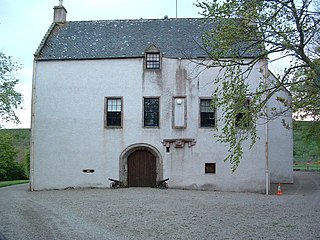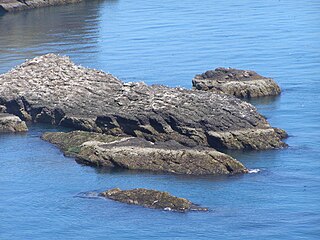| Inglismaldie Castle | |
|---|---|
| Marykirk | |
 Drawing of Inglismaldie Castle |
Inglismaldie Castle is a castle in the parish of Marykirk and the county of Kincardineshire, Scotland. [1] [2]
| Inglismaldie Castle | |
|---|---|
| Marykirk | |
 Drawing of Inglismaldie Castle |
Inglismaldie Castle is a castle in the parish of Marykirk and the county of Kincardineshire, Scotland. [1] [2]
The Tower House was built in 1636. It was revised in 1882 by the Aberdeen-based architect James Matthews. At that time, Inglismaldie was one of the properties of the Earl of Kintore.
In 2007, the pigeon house was added to the register of endangered listed buildings in Scotland. Seven years later, its condition was classified as very poor with moderate risk. [3]

Kincardineshire, also known as the Mearns, is a historic county, registration county and lieutenancy area on the coast of northeast Scotland. It is bounded by Aberdeenshire on the north and west, and by Angus on the south.

Fetteresso Castle is a 14th-century tower house, rebuilt in 1761 as a Scottish Gothic style Palladian manor, with clear evidence of prehistoric use of the site. It is situated immediately west of the town of Stonehaven in Kincardineshire, slightly to the west of the A90 dual carriageway. Other notable historic fortified houses or castles in this region are Dunnottar Castle, Muchalls Castle, Fiddes Castle, Cowie Castle and Monboddo House.

Hallyards Castle, located to the north-west of the village of Auchtertool, is reputed to have been a hunting seat of Malcolm Canmore. With the establishment of the Roman Church, Halyards became the local residence of the Bishops of Dunkeld; it remained so until the first lay proprietor took possession in 1539.

Allardice Castle is a sixteenth-century manor house in Kincardineshire, Scotland. It is approximately 1.5 kilometres northwest of the town of Inverbervie. The Bervie Water flows around Allardice Castle on both sides. Allardice may be viewed as one of a chain of coastal castles; to the north are Dunnottar Castle (ruined), Fetteresso Castle, Cowie Castle (ruined) and Muchalls Castle. The castle is a category A listed building. Allardice castle was the chief seat of the Barons of Allardice, an ancient family who first appear in an 1197 charter. Since 1542 many alterations and changes have been made to the original structure.

Cowie is an historic fishing village in Kincardineshire, Scotland. This village has existed since the Middle Ages, but in current times it is effectively subsumed into the town of Stonehaven. It had an estimated population of 2,720 in 2020.

Drumtochty Castle is a neo-gothic style castellated mansion erected in the year 1812 approximately three kilometres northwest of Auchenblae, Kincardineshire, Scotland. This building stands on the southern edge of Drumtochty Forest.
Drumtochty Forest is a coniferous woodland in Kincardineshire, Scotland. In earlier times this forest was associated with Drumtochty Castle. Other notable buildings in this part of the Mearns include Fasque House, Fetteresso Castle, and Muchalls Castle.

Rickarton House is a 19th-century country house in Kincardineshire, Scotland. It lies approximately three-and-a-half miles northwest of Stonehaven in the former county of Kincardineshire. The house is situated on the north banks of the Cowie Water slightly upstream of the confluence with Cowton Burn. Rickarton is a category B listed building. Rickarton House was constructed in the first decade of the 19th century for William Rickart Hepburn. He commissioned the City Architect of Aberdeen, John Smith, to undertake the work.

Craiglethy is a small island/skerry off Fowlsheugh on the east coast of Aberdeenshire, Scotland in the North Sea. As it is part of Fowlsheugh, it is an SSSI, with many seabirds and seals living on it. It is also one of the few islands on the east coast of Scotland, along with Mugdrum Island and Inchcape, apart from the Islands of the Forth.

Marykirk is a village in the Kincardine and Mearns area of Aberdeenshire, Scotland, next to the border with Angus at the River North Esk.

Lauriston Castle stands on a clifftop site near the Aberdeenshire village of St Cyrus and just over a mile inland from the North Sea coast of Scotland. Once a royal fortress, it can claim to be one of the oldest privately owned and inhabited castles in the region. It is a Category C listed building.

Collace is a parish in Perthshire, Scotland, 8 miles northeast of Perth, in the Carse of Gowrie district. The parish boundary includes the neighbouring villages of Kinrossie and Saucher.

Leuchars Castle, was a castle that was located near Leuchars, Fife, Scotland.
Harden Castle is a 16th century tower house, about 3.5 miles (5.6 km) west of Hawick, Scottish Borders. It is alternatively known as Harden House or Harden Tower.
Kincardine was a burgh in Scotland, near the present-day village of Fettercairn. It served as the first county town of Kincardineshire.
Marykirk railway station served the village of Marykirk, Kincardineshire, Scotland from 1849 to 1956 on the Aberdeen Railway.

Dalnair Castle, also known as Dalnair House, is a Scottish baronial castle dating from around 1884. It is located outside the village of Croftamie in Stirling, Scotland, on the edge of Loch Lomond and The Trossachs National Park.
Gartly Castle was a 15th-century castle, about 1 mile (1.6 km) north-east of Gartly, Aberdeenshire, Scotland, and 4 miles (6.4 km) south of Huntly, east of the River Bogie.
Hawkhead Castle was a castle existing in the 17th century, about 1 mile (1.6 km) east of Paisley, Renfrewshire, Scotland, south of the White Cart River.

Thornton Castle, Marykirk, Aberdeenshire is a fortress or fortified residence in Marykirk, Aberdeenshire. Parts of the house date from 1531.
Coordinates: 56°47′32″N2°35′06″W / 56.7922°N 2.5849°W